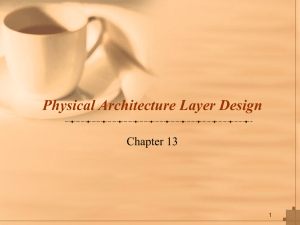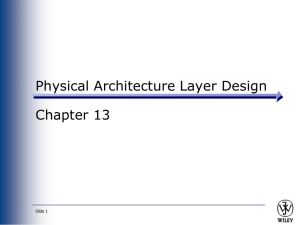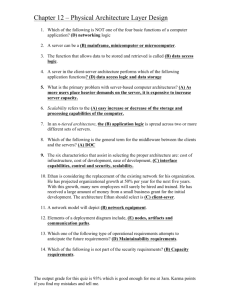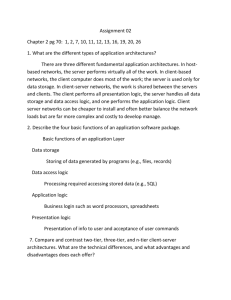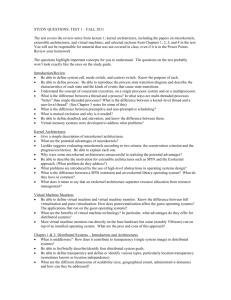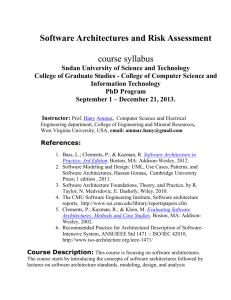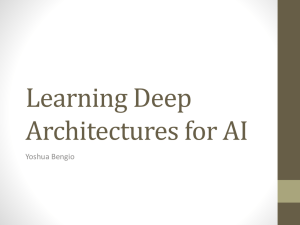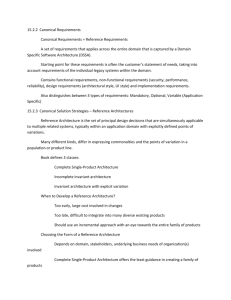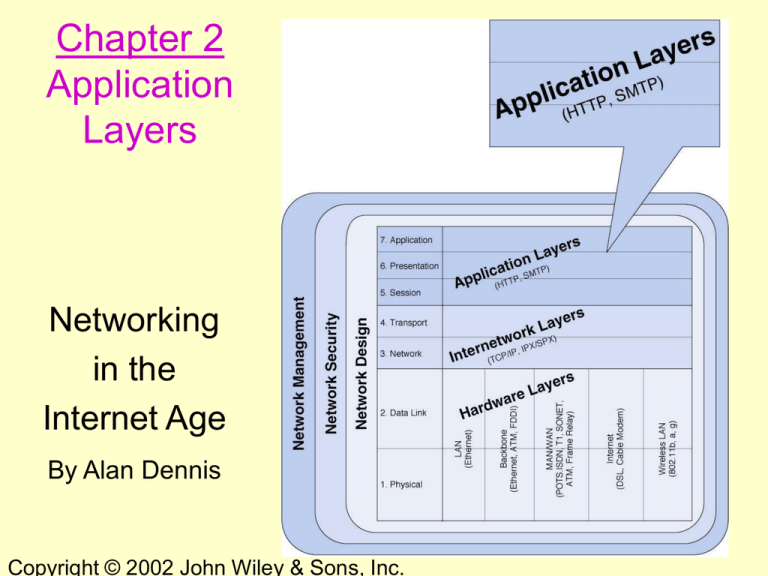
Chapter 2
Application
Layers
Networking
in the
Internet Age
By Alan Dennis
1
Copyright © 2002 John Wiley & Sons, Inc.
Copyright John Wiley & Sons, Inc. All rights reserved.
Reproduction or translation of this work beyond that named in
Section 117 of the United States Copyright Act without the
express written consent of the copyright owner is unlawful.
Requests for further information should be addressed to the
Permissions Department, John Wiley & Sons, Inc. Adopters of
the textbook are granted permission to make back-up copies for
their own use only, to make copies for distribution to students of
the course the textbook is used in, and to modify this material to
best suit their instructional needs. Under no circumstances can
copies be made for resale. The Publisher assumes no
responsibility for errors, omissions, or damages, caused by the
use of these programs or from the use of the information
contained herein.
2
Chapter 2. Learning Objectives
• Understand host-based, client-based, and
client-server architectures
• Understand how the Web works
• Understand how e-mail works
• Be aware of how FTP, Telnet, and Instant
Messaging work
3
Chapter 2. Outline
• Introduction
• Application Architectures
– Host-Based, Client-Based, and Client-Server
Architectures, Choosing Architectures
• World Wide Web
– How the Web Works, Inside an HTTP Request & HTTP
Response
• Electronic Mail
– How E-Mail Works, Inside an SMTP Packet
– Listserv, Attachments in MIME
• Other Applications
– Ftp, Telnet, Instant Messaging, Videoconferencing
4
Application Architectures
5
Application Architectures
• Application programs can be thought of as being
made up of four functions:
–
–
–
–
Data storage
Data access logic
Application logic
Presentation logic
• Application architectures are determined by how these
functions are split between clients and servers.
• Three basic application architectures are in use today:
– Host-based Architectures
– Client-based architectures
– Client-server architectures
6
Host-based Architectures
• The first application architecture to be
developed was the host-based.
• The ‘server’ in host-based architectures,
usually a mainframe, performs all four
application program functions.
• The client, usually a terminal or a PC running a
terminal emulation program captures key
strokes which are sent to the mainframe and
displays information according to the server’s
instructions (Figure 2-1).
7
Figure 2-1 Host-Based Architectures
8
Host-based Architectures
• There are two main problems with host-based
architectures:
– Since all processing is by the host, the host
becomes a bottleneck which can severely limit
network performance.
– Upgrades are typically expensive and “lumpy”,
meaning available upgrades require big jumps in
processing and memory. Network demand grows
more incrementally, so this often means a poor fit
(too much or too little) between host performance
and network demand.
9
Client-Based Architectures
• Client-based architectures became important in
the late 1980s with the widespread use of PCs,
local area networks, and low-cost PC-based
application programs such as spreadsheets and
word processors.
• In client-based architectures, application
programs on the clients are responsible for the
data access, application, and presentation logic.
• The server is responsible for data storage only
(Figure 2-2).
10
Figure 2-2 Client-Based Architectures
11
Client-Based Architectures
• The main problem with client-based
architectures is the need for all of the data to
travel back and forth between server and client.
• For example, if the client program is making a
database query, the entire database must travel
to the client before the query can be processed.
• The result can be poor network performance
due to the bottleneck created by constantly
sending large files back and forth over the
network.
12
Client-Server Architectures
• In client-server architectures the application
program functions are divided up between
clients and servers.
• The client takes care of the presentation logic.
• The server handles data storage and data access
logic.
• Application logic may reside on the client,
server or be split up between the two.
• Most networks today use a client-server
architecture (see Figure 2-3).
13
Figure 2-3 Client-Server Architectures
14
Client-Server Architectures
• Client-server architectures are more efficient since
they distribute processing between client and server.
• Another strength is that they allow hardware and
software from different servers to be used together.
• This is also a weakness, since it is sometimes difficult
to get software from different vendors to work
together smoothly.
• For this reason, a third category of software, called
middleware was developed.
15
Middleware
• Middleware provides an interface for allowing client
application programs to interact with server
application programs.
• Middleware’s two main functions are:
– Providing a standard way of translating between software
from different vendors.
– Managing message transfer between client and server, thus
insulating network changes (such as adding a new server)
from the clients.
• Two of the most important middleware standards are:
Distributed Computing Environment (DCE) and
Common Object Request Broker Architecture
(CORBA).
16
Two-tier, Three-tier and N-tier
Architectures
• Figure 2-3 gives an example of a 2-tier client-server
architecture.
• In a three-tier architecture the application program
logic is split up between three computers. For
example (see Figure 2-4),
– the client handles the presentation logic.
– an application server handles the application logic.
– a database server handles the data storage and data access
logic.
• In an N-tier architecture more than three sets of
computers are used (see Figure 2-5).
17
Figure 2-4 A Three-tier Architecture
18
Figure 2-5 An N-tier Architecture
19
Two-tier, Three-tier and N-tier
Architectures
• The primary advantage of N-tier architectures is that
they make load balancing possible. Since the
application program logic is distributed between
several servers, processing can then be more evenly
distributed among those servers.
• N-tiered architectures are also more easily scalable,
since only servers experiencing high demand, such as
the application server, need be upgraded.
• The primary disadvantage is that more distributed
processing means a more heavily loaded network.
• It is also more difficult to program and test an N-tier
architecture due to its increased complexity.
20
Thin versus Fat Clients
• Thin and Fat (or thick) clients describe how much of
the application logic resides on the client.
– Little or no application logic resides on a thin client.
– All or most of the application logic resides on a fat client.
• Thin clients are becoming popular because they are
easier to manage, since only the server application
logic generally needs to be updated.
• The best example of a thin client is World Wide Web
architecture which uses a two-tier, thin client
architecture (Figure 2-6).
21
Figure 2-6 Web Architecture
22
Best Practice Architecture
• Often, the application architecture is given, so no
decision has to be made. When it is not, three
important criteria for choosing an architecture are:
– Cost of Infrastructure: mainframes are expensive, which
is why client-based and client-server architectures have
become popular.
– Cost of Development: because software is expensive to
develop, client-based and client-server architectures that use
off-the-shelf software tend to be much cheaper than
software solutions that require in-house development.
– Scalability refers to the ability to increase (or decrease) in
computing capacity as network demand changes. Clientserver architectures are the most scalable since both clients
and servers can be added to meet network needs.
23
Host-Based
Client-Based
Client-Server
Cost of
Infrastructure
High
Medium
Low
Cost of
Development
Low
Medium
High
Scalability
Low
Medium
High
Figure 2-7 Choosing an Architecture
24
The World Wide Web
25
Origin of the World Wide Web
• Invented in 1989 by Tim Berners-Lee at the Centre
Européan pour Rechèrche Nucleaire (CERN) in
Geneva.
• Two central WWW ideas are hyperlinks and Uniform
Resource Locators (URLs).
• Mosaic, the first web reader (browser) to gain
widespread use, was written in 1993 at the National
Center for Supercomputing Applications (NCSA) by
Marc Andressen, who later founded Netscape.
26
How the Web Works (Figure 2-8)
• Based on a Client-Server architecture
• The main Web communications protocol is Hypertext
Transfer Protocol.
• Web clients (browsers) make HTTP requests to Web
servers. Web servers answer with HTTP responses.
• Clicking on a hyperlink or typing a URL into a
browser starts an HTTP request-response cycle.
• An HTTP request-response cycle can have multiple
steps since many web pages often contain embedded
files, such as graphics, each requiring a separate
response.
27
Figure 2-8 How the Web Works
28
HTTP Requests have 3 parts:
• Request line (required): starts with a command
and URL and ends with the http version number.
• Request header (optional): contains information
on the browser, date, and the referring page from
which the request originated. If the user types in
the URL by themselves, then the referring page is
blank.
• Request body (optional): contains information
sent to the server, such as from a form.
29
Command
URL
HTTP version
GET http://www.kelley.indiana.edu/ardennis/home.htm HTTP/1.1 ]- Request
Line
Date: Mon 06 Aug 2001 17:35:46 GMT ]- Date
User-Agent: Mozilla/6.0 ]- Web browser (this is Netscape)
Request Header
Referer: http://www.indiana.edu/~aisdept/faculty.htm
URL that contained the link to the requested URL
Figure 2-9 Example of an HTTP Request from
a Web browser
30
HTTP Responses also have 3 parts:
• Response status (optional): http version number,
status code (e.g., 200 = ok, 404 = page not found)
and “reason” phrase (description of status code).
• Response header (optional): contains information on
the server, date, exact URL of the retrieved page and
format used for the body of the response (e.g., html).
• Response body (required): contains the requested
Web page.
31
HTTP ver. Status code Reason
HTTP/1.1
200
OK ]- Response Status
Date: Mon 06 Aug 2001 17:35:46 GMT ]- Date
Response Header
Server: NCSA/1.3 ]- Web server
Location: http:// www.kelley.indiana.edu/adennis/home.htm ]- URL
Content-type: text/html]- Type of file
<html>
<head>
<title>Allen R. Dennis</title>
</head>
Response
<body>
Body
<H2> Allen R. Dennis </H2>
<P>Welcome to the home page of Allen R. Dennis</P>
</body>
</html>
Figure 2-10 HTTP response from a Web server
32
Hypertext Markup Language (HTML)
• Web pages are formatted using another protocol,
usually HTML, also developed at CERN.
• HTML documents include information on how to
format the file imbedded in the document called tags.
• HTML was initially developed for text files, not
multimedia files. This is why extensions to HTML
have been needed.
• And also why other markup language formats have
been created, such as Extensible Markup Language
(XML).
33
Electronic Mail
34
Electronic Mail
• Still the most heavily used Internet
application because:
– It’s much, much faster than regular mail.
– It’s extremely inexpensive.
– It can substitute for other forms of
communication, such as telephone calls.
– E-mail users don’t have to play “telephone tag”,
since the respondent can answer at his/her
convenience, instead of time of call.
35
E-mail standards
• Simple Mail Transfer Protocol (SMTP):
part of the TCP/IP protocol suite.
• SMTP is the main e-mail standard for mail
transfer agents in use today, but was written
to only handle text files.
• SMTP is usually implemented using a twotier client-server architecture.
• Two other competing standards for e-mail
are Common Messaging Calls (CMC) and
X.400.
36
Two-Tier E-mail Architecture
• SMTP uses two types of programs:
• User agents, also called e-mail clients, are
programs running on client computers that send email to e-mail servers and download e-mail from
mailboxes on those servers.
– Post Office Protocol (POP) & Internet Mail Access
Protocol (IMAP) are the main protocols for user agent
to mail server communications (e.g., Eudora, Outlook).
• Mail transfer agents, also called mail server
software, are used by e-mail servers. They send email between e-mail servers and maintain
individual mailboxes.
37
Sending An E-mail Message (Figure 2-11)
• When completed, an e-mail message is sent by the
sender’s e-mail client as an SMTP packet to the
local mail server.
• The mail server’s message transfer agent next
reads the packet’s destination address and sends it
over the Internet to the receiver’s mail server.
• The destination mail transfer agent then stores the
message in the receiver’s mail box.
• When the receiver next accesses e-mail, his or her
user agent contacts the local mail server which
then downloads the message to the receiver’s
client computer.
38
Figure 2-11 How SMTP e-mail works
39
Three-Tier Client-Server Architecture
(Figure 2-12)
• Reading e-mail using a Web-based
interface, such as Hotmail, uses a three-tier
architecture. The three tiers are:
– The client’s web browser that sends HTTP
requests to the Web server.
– The Web server: 1) sends HTTP responses to
the Web client and 2) translates the client’s
HTTP requests into SMTP packets which are
then sent to the Mail server.
– The Mail server performs the same functions as
the mail server in the two-tier example.
40
Figure 2-12 How Web-based e-mail works
41
Simple Mail Transfer Protocol
• SMTP E-mail messages have the following
structure:
– Header: lists source and destination addresses,
date, subject, and other information about the email message.
– Body: the message itself.
– Attachments: additional files that have been
included along with the e-mail message.
42
From: “Alan Dennis;”<adennis@indiana.edu>
TO: “Pat Someone” <someone@somewhere.com>
Date: Mon 06 Aug 2001 19:03:02 GMT
Subject: Sample Note
Message-Id:
<4.1.20000623164823.009f5e80@IMAP.IU.EDU>
DATA:
This is an example of an e-mail message
Message
header
Message
body
Fig. 2-13 Sample E-mail Message using SMTP
43
Attachments in MIME
• Since SMTP was developed for transferring text files,
special techniques needed to be developed to send
graphical information.
• Graphics capable mail transfer agent protocols include
MIME (Multipurpose Internet Mail Extension),
uuencode and binhex.
• Included as part of an e-mail client, MIME translates
graphical information into text allowing the graphic to
be sent as part of an SMTP message.
• The receiver’s e-mail client then translates the MIME
attachment from text back into graphical format.
44
Other Applications
45
File Transfer Protocol (FTP) and Telnet
• FTP enables sending and receiving files
over the Internet.
• Telnet allows remote logins over the
Internet.
• Both were much more commonly used
during the pre-WWW days of the Internet.
• FTP is still commonly used today for
uploading web pages.
46
IM: Instant Messaging (Figure 2-14)
• IM is a client-server program that allows real-time
messages to be exchanged. Some types also allow
voice and video packets to be sent. Examples include
AOL and ICQ.
• IM works as follows:
– Your IM client first sends a request to the IM server telling
it that you are online. If a friend connects, the IM server
sends a packet to your IM client and vice versa.
– When you type some text, your IM client sends the text in a
packet to the IM server which relays it to your friend.
– If a chat session has more than two clients, multiple packets
are sent by the IM server. IM servers can also relay
information to other IM servers.
47
Figure 2- 14 How Instant Messaging works
48
Videoconferencing
• Allows people to “meet” and interact at the same
time but in different locations, typically saving
money and time by not having people move
around to attend meetings.
• Conference calling does the same thing.
• Usually involves 2 meeting rooms only.
• Desktop videoconferencing is a related, low cost
application linking small video cameras and
microphones together over the Internet.
49
End of Chapter 2
50

